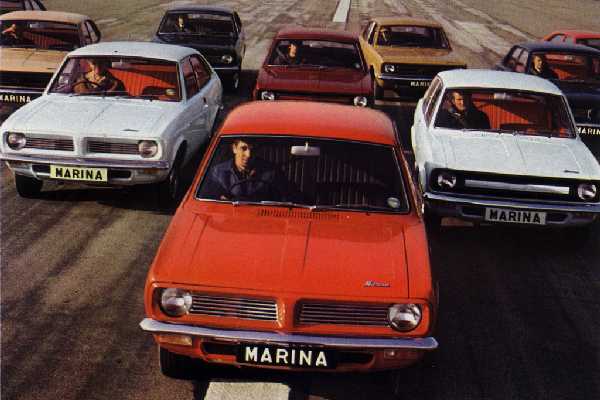The towering monolith of the now long deceased British Leyland Motor Corporation began crumbling soon after its creation in 1968.
By 1972, British car sales were on a high, but BLMC’s industrial relations were plumbing new depths. In those four years the corporation’s British market share dropped from near 40% to just over 33% – quite unprecedented figures today, but a pointer to looming catastrophe back then. At the time, just getting cars like the recently launched Marina, Maxi and new Allegro built was proving a major management headache, and then came the 1973 oil crisis.
Sales collapsed, losses mounted, bankers fretted, expansion plans abandoned. With an overdraft perilously close to its £150m limit, late in 1974 BLMC was in a major financial crisis. On 6 December, the House of Commons heard from Industry Secretary Tony Benn that government money should be used to “assist the company.”
Plans were duly laid, £50m of bank lending was approved with government controls over decisions and on 18 December, businessman and former journalist Sir Don Ryder was appointed to prepare a report on the company’s future.
Incredibly, the Ryder Report was delivered to government in just 14 weeks, with its non-redacted contents became public forty years ago last week – on 24 April. Key recommendations included immediate attention to major industrial relations problems, and development of a rational, cohesive new model strategy to end extensive overlap in the vast model range.
Surprisingly, there was no suggestion to reduce over-manning, an endemic BLMC problem, or plant closures, though organisational rationalisation of factory facilities was mentioned. There were also calls for major and urgent investment in modern manufacturing machinery, and new vehicle test and development facilities. Particular criticism was directed at senior management.
Ryder was remarkably – even hopelessly – optimistic about the company’s future, and sought expansion, apparently blind to the design, quality and supply problems that then lay behind the fading popularity of BL cars.
Nor was there any apparent anticipation of rising customer expectations, changing market dynamics, or the challenge of growing Japanese competition. Despite steadily falling exports, Ryder expected Western European market share to increase from under 3% to nearly 3.6% by 1981/82, and 3.9% by 1984/85. At home, BLMC was expected to retain a 33% share in future – though as the report was published, it had slipped to around 30%, with Ford then taking about 21%.
The report saw established brand identities remaining, with the company’s cars continuing in both volume and specialist sectors. An integrated development, manufacturing and marketing approach was demanded to maximise resource utilisation, from which sprang a contentious aspect of new strategy.
Ryder wanted to incorporate all BL cars from basic Mini to luxurious Daimler into a single autonomous Leyland car division, while other proposed divisions – Trucks and buses, special products, and International – remained much as before.
Ryder’s financial plan required enormous levels of investment, believed necessary to make BLMC competitive in future – and sourced entirely from Government. Astonishing capital expenditure (at constant 1975 prices) of some £1.264 billion was proposed by 1981, with an additional £260m working capital. £900m was required in three stages by 1978, with the proviso that “before tranches of new money are put in, there should be reviews of the contribution being made by BL’s workers and management to the improvement of productivity and efficiency.”

Harold Wilson’s Cabinet and government fully accepted the findings, commanding its key recommendations be quickly enacted; to keep BLMC afloat, effective nationalisation under the new name British Leyland Ltd followed in June 1975.
Top level resignations then kept the exit doors swinging for some time, with departures led by deputy chairman and managing director John Barber, followed days later by the Chairman, Lord Stokes.
Sir Don Ryder himself was appointed first Chairman of the new National Enterprise Board which had the task of overseeing the report’s implementation. One Michael Edwardes joined the NEB in 1976: he must have seen how crippling strikes were continuing, while attempts to gain control of the situation had little apparent impact.
By this stage a new government was demanding concrete signs of British Leyland’s revival, but strikes continued, production was erratic and quality variable, and the Ryder plan was fast unraveling.
A freeze on further finance was threatened and early in 1977 the infamous Toolmakers’ strike began. That year Ford was Britain’s best selling car brand: BL’s share was down to 24%…. with worse still to come.
Sir Don Ryder fielded much of the blame for the failure, and resigned from the NEB in summer 1977, afterwards retiring from high-profile public life and he died in May 2003.
By 1977 British Leyland was back on a financial knife-edge: a determined hands-on boss was urgently needed, with full government backing to force through new plans for survival. Enter Michael Edwardes, who started work in November 1977.
With the company renamed BL Ltd, major restructuring began in earnest, opening yet another new chapter in the story. Edwardes addressed long-neglected problems in brazen, no-nonsense style, which brought much union confrontation, factory closures, and ultimately the biggest shakeout of labour in British motor industry history.
By 1978 the Ryder report was revealed for what it was: an outrageously ambitious, under-researched plan, formulated in haste and sporadically implemented. On the surface its lasting influence was minimal, though the rationalisation of burgeoning future model plans it demanded was overdue from both financial and marketing perspectives.

Amongst product casualties of the time were the ADO77 Cortina challenger, the downsized Rover SD2 and the ethereal TM 1; several other cars were cancelled later. Two fortunate survivors stand out: the ADO 99, later LC 10, LM 10… and eventually the Austin Maestro – which snatched sales defeat from the jaws of victory… and ADO74, subsequently developed into ADO88 and later LC 8 – before finally becoming the highly successful mini-metro (above).
By 1979 cancelled products and cash shortages saw Michael Edwardes obliged to choose a Japanese car for stop-gap salvation. That decision, with downsizing and moves towards privatisation, radically changed BL’s future course, ensuring this story would continue unfolding for years to come. The Ryder Report, however, was soon forgotten.
REFERENCES
A redacted version of the Ryder Report is available in PDF format here:
http://filestore.nationalarchives.gov.uk/pdfs/small/cab-129-183-c-75-53-3.pdf
Sir Don Ryder’s Obituary in the Telegraph newspaper, May 2003:
http://www.telegraph.co.uk/news/obituaries/1430066/Lord-Ryder-of-Eaton-Hastings.html
Sir Don Ryder (b Sydney Franklin Thomas Ryder) in the Oxford Dictionary of National Biography:
http://www.oxforddnb.com/view/article/90001?docPos=19
Further reading
Book: “Back from the Brink” by Michael Edwardes. Pub: Collins. 1983.
ISBN 0002170744
Dave Moss has a lifetime connection with the world of motoring. His father was a time-served skilled engineer from an age when car repairs really meant repairs: he ran his own garage from the 1930's to the 60's, while Mum was the boss's secretary at a big Austin distributor. Both worked their entire lives in the motor trade, so if motor oil's not in Dave's blood, its surely a very close thing.
Though qualified in Electronics, for Dave it seemed a natural step into restoring a succession of classic cars, culminating in a variety of Minis. Writing and broadcasting about these, and a widening range of motoring matters ancient and modern, gathered pace in the 1970's and has taken over since. Topics nowadays range across the modern motoring mainstream to the offbeat and more arcane aspects of motoring history, and outlets embrace books, websites national and international magazines, newspapers, radio programmes, phone-ins and guest appearances. Spare time: hard graft on the garage floor attending to vehicles old and new. Latest projects: that 1968 Mini Cooper S has finally moved again after 30 years, and when the paint is finished, the 1960 Morris Mini 850 will also soon be ready for the road again...

